University Food Fundamentals: Packaging and Labeling Report
VerifiedAdded on 2020/03/15
|8
|1542
|225
Report
AI Summary
This report, titled "Food Fundamentals," examines the critical aspects of food packaging and labeling, using milk products (skimmed milk and fresh milk) as case studies. The report begins with an executive summary and table of contents, followed by an introduction that emphasizes the importance of attractive and hygienic packaging in the fast-moving consumer goods market to extend product life and enhance marketability. The report then explores the functions of packaging, including the use of hard plastic containers for 2-liter skimmed milk and pouch packets for fresh milk. It discusses the use of plastic materials, weighing the benefits of plastic containers (durability, cost-effectiveness, and convenience) against environmental considerations. The report highlights the need for degradable plastics and recycling to mitigate environmental impact. Labeling requirements, including brand name, ingredients, nutritional value, and manufacturing details, are discussed. The report concludes by referencing the Australian Guide to Healthy Eating, recommending appropriate milk consumption based on age groups and packaging suitability, and emphasizing the role of packaging in product storage and portability. The report also references several sources to support its claims.
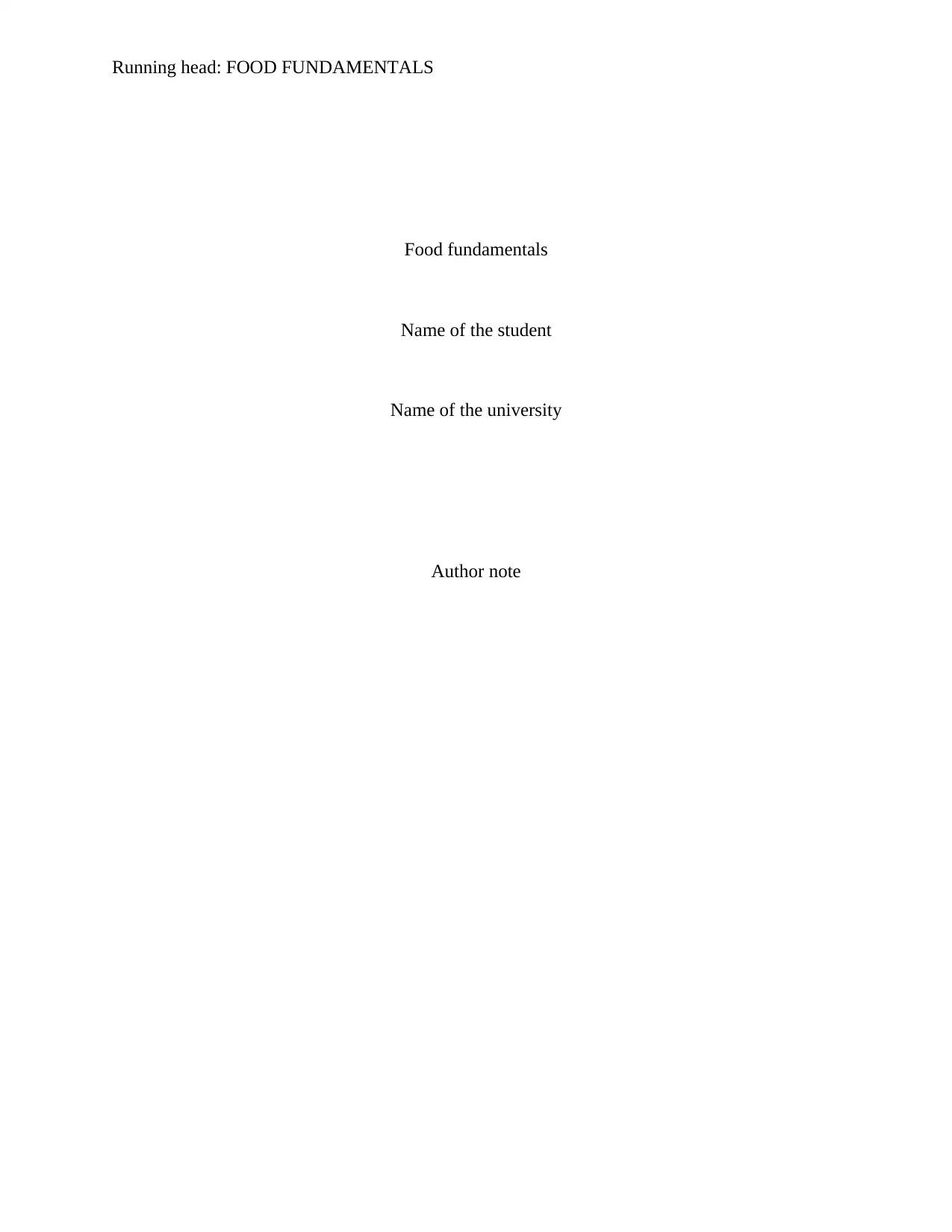
Running head: FOOD FUNDAMENTALS
Food fundamentals
Name of the student
Name of the university
Author note
Food fundamentals
Name of the student
Name of the university
Author note
Paraphrase This Document
Need a fresh take? Get an instant paraphrase of this document with our AI Paraphraser

1FOOD FUNDAMENTALS
Executive summary
The aim of this report is to discuss about the various aspects of packaging and labeling the food
items such as milk. Required elements in this process had been discussed in this report. In
reference to Australian guide to healthy eating, an ideal serving is also been recommended in this
report.
Executive summary
The aim of this report is to discuss about the various aspects of packaging and labeling the food
items such as milk. Required elements in this process had been discussed in this report. In
reference to Australian guide to healthy eating, an ideal serving is also been recommended in this
report.

2FOOD FUNDAMENTALS
Table of Contents
Introduction......................................................................................................................................3
Function of packaging.....................................................................................................................3
Use of plastic material.....................................................................................................................4
Environmental consideration...........................................................................................................4
Labeling the products......................................................................................................................5
Conclusion.......................................................................................................................................6
Reference.........................................................................................................................................7
Table of Contents
Introduction......................................................................................................................................3
Function of packaging.....................................................................................................................3
Use of plastic material.....................................................................................................................4
Environmental consideration...........................................................................................................4
Labeling the products......................................................................................................................5
Conclusion.......................................................................................................................................6
Reference.........................................................................................................................................7
⊘ This is a preview!⊘
Do you want full access?
Subscribe today to unlock all pages.

Trusted by 1+ million students worldwide
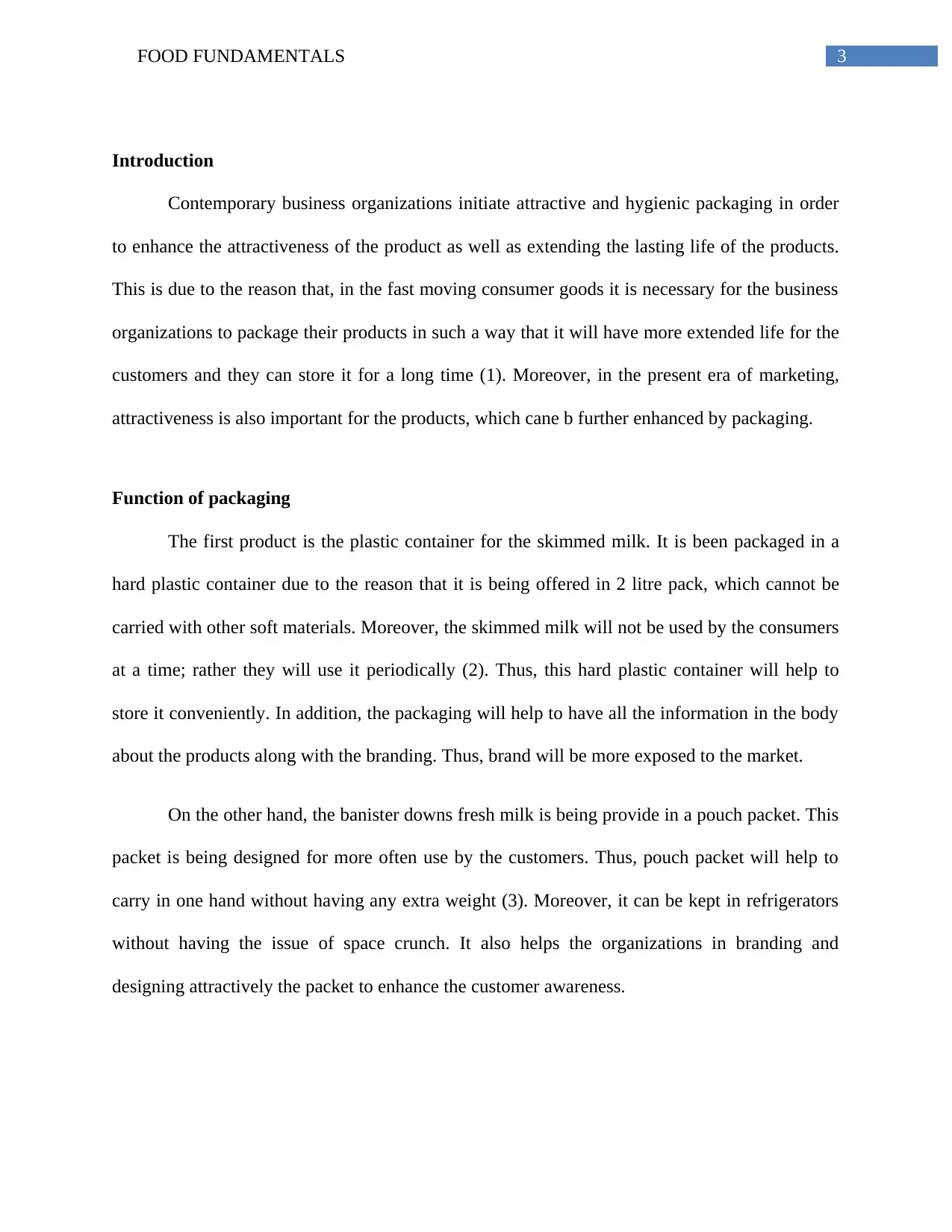
3FOOD FUNDAMENTALS
Introduction
Contemporary business organizations initiate attractive and hygienic packaging in order
to enhance the attractiveness of the product as well as extending the lasting life of the products.
This is due to the reason that, in the fast moving consumer goods it is necessary for the business
organizations to package their products in such a way that it will have more extended life for the
customers and they can store it for a long time (1). Moreover, in the present era of marketing,
attractiveness is also important for the products, which cane b further enhanced by packaging.
Function of packaging
The first product is the plastic container for the skimmed milk. It is been packaged in a
hard plastic container due to the reason that it is being offered in 2 litre pack, which cannot be
carried with other soft materials. Moreover, the skimmed milk will not be used by the consumers
at a time; rather they will use it periodically (2). Thus, this hard plastic container will help to
store it conveniently. In addition, the packaging will help to have all the information in the body
about the products along with the branding. Thus, brand will be more exposed to the market.
On the other hand, the banister downs fresh milk is being provide in a pouch packet. This
packet is being designed for more often use by the customers. Thus, pouch packet will help to
carry in one hand without having any extra weight (3). Moreover, it can be kept in refrigerators
without having the issue of space crunch. It also helps the organizations in branding and
designing attractively the packet to enhance the customer awareness.
Introduction
Contemporary business organizations initiate attractive and hygienic packaging in order
to enhance the attractiveness of the product as well as extending the lasting life of the products.
This is due to the reason that, in the fast moving consumer goods it is necessary for the business
organizations to package their products in such a way that it will have more extended life for the
customers and they can store it for a long time (1). Moreover, in the present era of marketing,
attractiveness is also important for the products, which cane b further enhanced by packaging.
Function of packaging
The first product is the plastic container for the skimmed milk. It is been packaged in a
hard plastic container due to the reason that it is being offered in 2 litre pack, which cannot be
carried with other soft materials. Moreover, the skimmed milk will not be used by the consumers
at a time; rather they will use it periodically (2). Thus, this hard plastic container will help to
store it conveniently. In addition, the packaging will help to have all the information in the body
about the products along with the branding. Thus, brand will be more exposed to the market.
On the other hand, the banister downs fresh milk is being provide in a pouch packet. This
packet is being designed for more often use by the customers. Thus, pouch packet will help to
carry in one hand without having any extra weight (3). Moreover, it can be kept in refrigerators
without having the issue of space crunch. It also helps the organizations in branding and
designing attractively the packet to enhance the customer awareness.
Paraphrase This Document
Need a fresh take? Get an instant paraphrase of this document with our AI Paraphraser
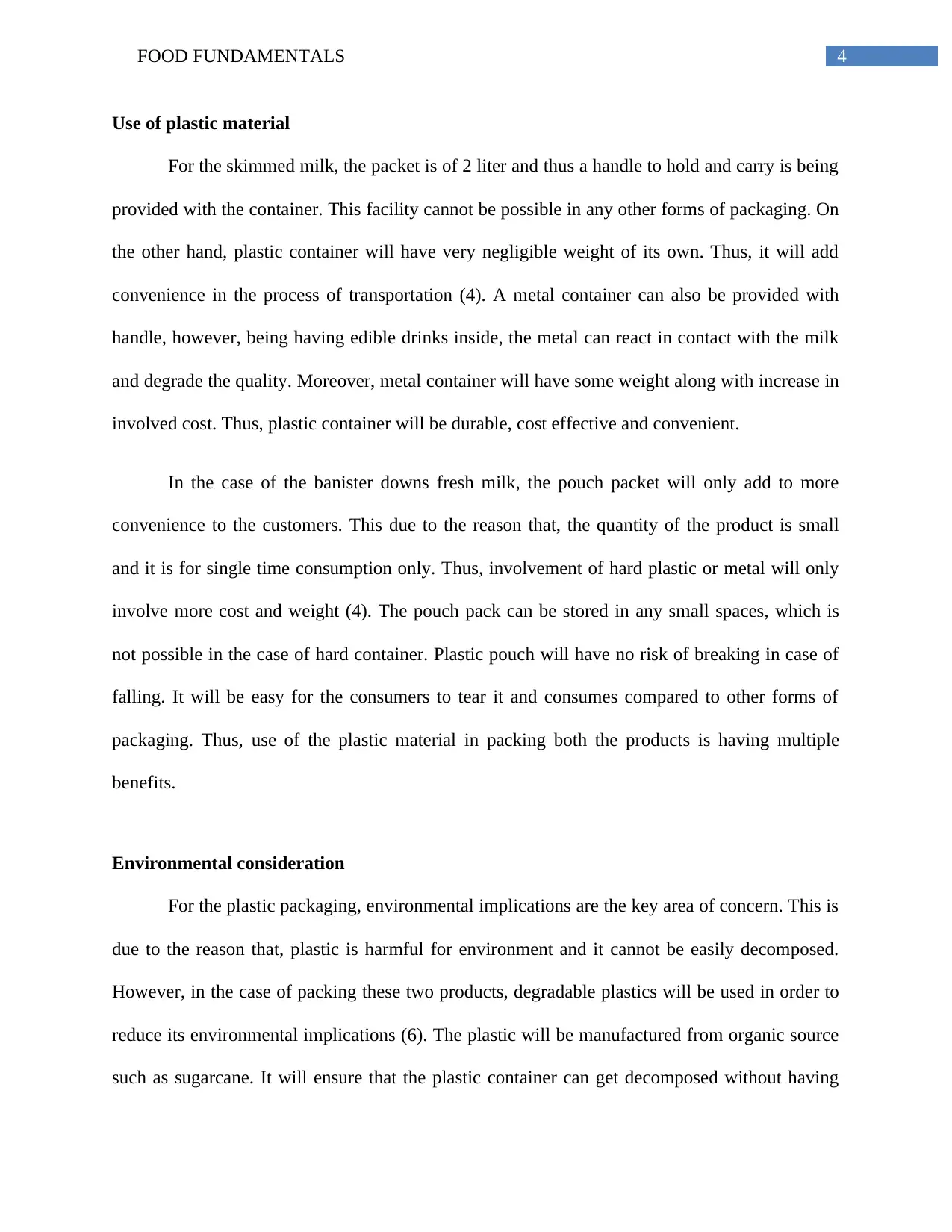
4FOOD FUNDAMENTALS
Use of plastic material
For the skimmed milk, the packet is of 2 liter and thus a handle to hold and carry is being
provided with the container. This facility cannot be possible in any other forms of packaging. On
the other hand, plastic container will have very negligible weight of its own. Thus, it will add
convenience in the process of transportation (4). A metal container can also be provided with
handle, however, being having edible drinks inside, the metal can react in contact with the milk
and degrade the quality. Moreover, metal container will have some weight along with increase in
involved cost. Thus, plastic container will be durable, cost effective and convenient.
In the case of the banister downs fresh milk, the pouch packet will only add to more
convenience to the customers. This due to the reason that, the quantity of the product is small
and it is for single time consumption only. Thus, involvement of hard plastic or metal will only
involve more cost and weight (4). The pouch pack can be stored in any small spaces, which is
not possible in the case of hard container. Plastic pouch will have no risk of breaking in case of
falling. It will be easy for the consumers to tear it and consumes compared to other forms of
packaging. Thus, use of the plastic material in packing both the products is having multiple
benefits.
Environmental consideration
For the plastic packaging, environmental implications are the key area of concern. This is
due to the reason that, plastic is harmful for environment and it cannot be easily decomposed.
However, in the case of packing these two products, degradable plastics will be used in order to
reduce its environmental implications (6). The plastic will be manufactured from organic source
such as sugarcane. It will ensure that the plastic container can get decomposed without having
Use of plastic material
For the skimmed milk, the packet is of 2 liter and thus a handle to hold and carry is being
provided with the container. This facility cannot be possible in any other forms of packaging. On
the other hand, plastic container will have very negligible weight of its own. Thus, it will add
convenience in the process of transportation (4). A metal container can also be provided with
handle, however, being having edible drinks inside, the metal can react in contact with the milk
and degrade the quality. Moreover, metal container will have some weight along with increase in
involved cost. Thus, plastic container will be durable, cost effective and convenient.
In the case of the banister downs fresh milk, the pouch packet will only add to more
convenience to the customers. This due to the reason that, the quantity of the product is small
and it is for single time consumption only. Thus, involvement of hard plastic or metal will only
involve more cost and weight (4). The pouch pack can be stored in any small spaces, which is
not possible in the case of hard container. Plastic pouch will have no risk of breaking in case of
falling. It will be easy for the consumers to tear it and consumes compared to other forms of
packaging. Thus, use of the plastic material in packing both the products is having multiple
benefits.
Environmental consideration
For the plastic packaging, environmental implications are the key area of concern. This is
due to the reason that, plastic is harmful for environment and it cannot be easily decomposed.
However, in the case of packing these two products, degradable plastics will be used in order to
reduce its environmental implications (6). The plastic will be manufactured from organic source
such as sugarcane. It will ensure that the plastic container can get decomposed without having
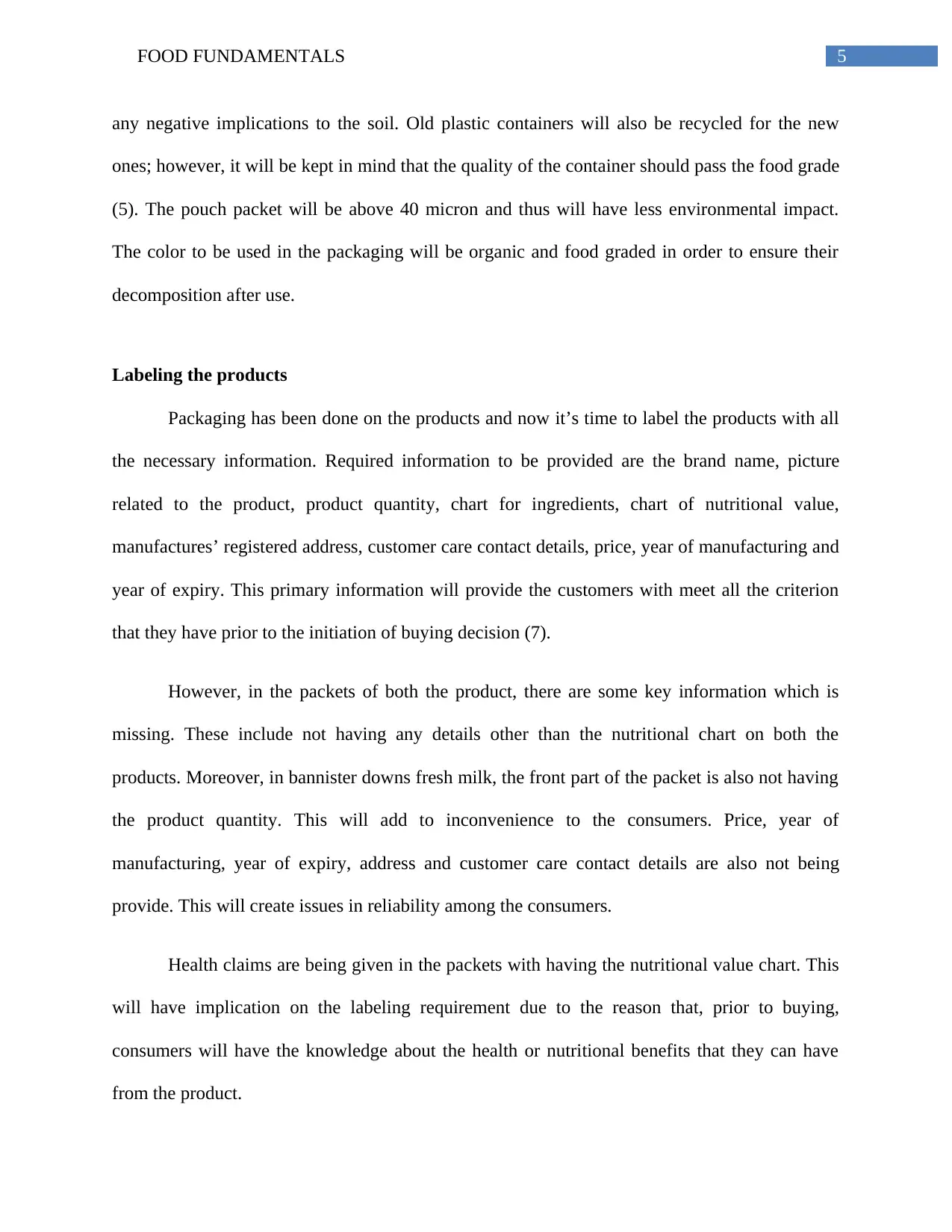
5FOOD FUNDAMENTALS
any negative implications to the soil. Old plastic containers will also be recycled for the new
ones; however, it will be kept in mind that the quality of the container should pass the food grade
(5). The pouch packet will be above 40 micron and thus will have less environmental impact.
The color to be used in the packaging will be organic and food graded in order to ensure their
decomposition after use.
Labeling the products
Packaging has been done on the products and now it’s time to label the products with all
the necessary information. Required information to be provided are the brand name, picture
related to the product, product quantity, chart for ingredients, chart of nutritional value,
manufactures’ registered address, customer care contact details, price, year of manufacturing and
year of expiry. This primary information will provide the customers with meet all the criterion
that they have prior to the initiation of buying decision (7).
However, in the packets of both the product, there are some key information which is
missing. These include not having any details other than the nutritional chart on both the
products. Moreover, in bannister downs fresh milk, the front part of the packet is also not having
the product quantity. This will add to inconvenience to the consumers. Price, year of
manufacturing, year of expiry, address and customer care contact details are also not being
provide. This will create issues in reliability among the consumers.
Health claims are being given in the packets with having the nutritional value chart. This
will have implication on the labeling requirement due to the reason that, prior to buying,
consumers will have the knowledge about the health or nutritional benefits that they can have
from the product.
any negative implications to the soil. Old plastic containers will also be recycled for the new
ones; however, it will be kept in mind that the quality of the container should pass the food grade
(5). The pouch packet will be above 40 micron and thus will have less environmental impact.
The color to be used in the packaging will be organic and food graded in order to ensure their
decomposition after use.
Labeling the products
Packaging has been done on the products and now it’s time to label the products with all
the necessary information. Required information to be provided are the brand name, picture
related to the product, product quantity, chart for ingredients, chart of nutritional value,
manufactures’ registered address, customer care contact details, price, year of manufacturing and
year of expiry. This primary information will provide the customers with meet all the criterion
that they have prior to the initiation of buying decision (7).
However, in the packets of both the product, there are some key information which is
missing. These include not having any details other than the nutritional chart on both the
products. Moreover, in bannister downs fresh milk, the front part of the packet is also not having
the product quantity. This will add to inconvenience to the consumers. Price, year of
manufacturing, year of expiry, address and customer care contact details are also not being
provide. This will create issues in reliability among the consumers.
Health claims are being given in the packets with having the nutritional value chart. This
will have implication on the labeling requirement due to the reason that, prior to buying,
consumers will have the knowledge about the health or nutritional benefits that they can have
from the product.
⊘ This is a preview!⊘
Do you want full access?
Subscribe today to unlock all pages.

Trusted by 1+ million students worldwide

6FOOD FUNDAMENTALS
Conclusion
According to the Australian guide to healthy eating, milk is being made mandatory for all
age groups for daily consumption. Children below 2 years are being advised to have milk with
natural fat quantity. Thus for them bannister downs fresh milk will be suitable (8). For the above
age groups, skimmed milk will be perfect with reduced fat quantity. It is being recommended
that for age groups of approx 25 years, 2.5 times servings (each servings equals to 250ml) should
be consumed. Milk is being recommended mostly in breakfast. Thus, the portable packaging of
these products will enable the consumers to store the products for long use and pouch packs will
help them to maintain the average servings in anytime and anywhere.
Conclusion
According to the Australian guide to healthy eating, milk is being made mandatory for all
age groups for daily consumption. Children below 2 years are being advised to have milk with
natural fat quantity. Thus for them bannister downs fresh milk will be suitable (8). For the above
age groups, skimmed milk will be perfect with reduced fat quantity. It is being recommended
that for age groups of approx 25 years, 2.5 times servings (each servings equals to 250ml) should
be consumed. Milk is being recommended mostly in breakfast. Thus, the portable packaging of
these products will enable the consumers to store the products for long use and pouch packs will
help them to maintain the average servings in anytime and anywhere.
Paraphrase This Document
Need a fresh take? Get an instant paraphrase of this document with our AI Paraphraser
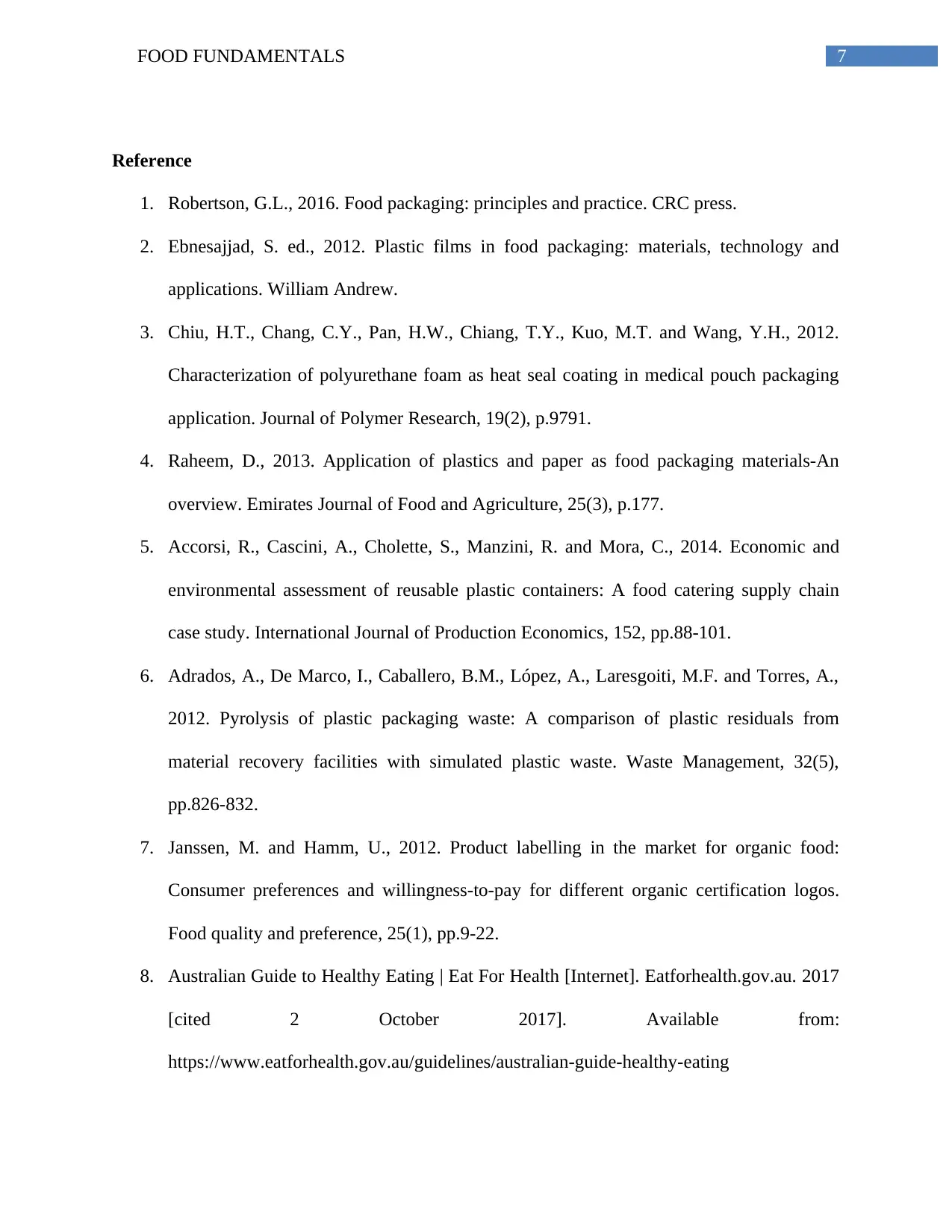
7FOOD FUNDAMENTALS
Reference
1. Robertson, G.L., 2016. Food packaging: principles and practice. CRC press.
2. Ebnesajjad, S. ed., 2012. Plastic films in food packaging: materials, technology and
applications. William Andrew.
3. Chiu, H.T., Chang, C.Y., Pan, H.W., Chiang, T.Y., Kuo, M.T. and Wang, Y.H., 2012.
Characterization of polyurethane foam as heat seal coating in medical pouch packaging
application. Journal of Polymer Research, 19(2), p.9791.
4. Raheem, D., 2013. Application of plastics and paper as food packaging materials-An
overview. Emirates Journal of Food and Agriculture, 25(3), p.177.
5. Accorsi, R., Cascini, A., Cholette, S., Manzini, R. and Mora, C., 2014. Economic and
environmental assessment of reusable plastic containers: A food catering supply chain
case study. International Journal of Production Economics, 152, pp.88-101.
6. Adrados, A., De Marco, I., Caballero, B.M., López, A., Laresgoiti, M.F. and Torres, A.,
2012. Pyrolysis of plastic packaging waste: A comparison of plastic residuals from
material recovery facilities with simulated plastic waste. Waste Management, 32(5),
pp.826-832.
7. Janssen, M. and Hamm, U., 2012. Product labelling in the market for organic food:
Consumer preferences and willingness-to-pay for different organic certification logos.
Food quality and preference, 25(1), pp.9-22.
8. Australian Guide to Healthy Eating | Eat For Health [Internet]. Eatforhealth.gov.au. 2017
[cited 2 October 2017]. Available from:
https://www.eatforhealth.gov.au/guidelines/australian-guide-healthy-eating
Reference
1. Robertson, G.L., 2016. Food packaging: principles and practice. CRC press.
2. Ebnesajjad, S. ed., 2012. Plastic films in food packaging: materials, technology and
applications. William Andrew.
3. Chiu, H.T., Chang, C.Y., Pan, H.W., Chiang, T.Y., Kuo, M.T. and Wang, Y.H., 2012.
Characterization of polyurethane foam as heat seal coating in medical pouch packaging
application. Journal of Polymer Research, 19(2), p.9791.
4. Raheem, D., 2013. Application of plastics and paper as food packaging materials-An
overview. Emirates Journal of Food and Agriculture, 25(3), p.177.
5. Accorsi, R., Cascini, A., Cholette, S., Manzini, R. and Mora, C., 2014. Economic and
environmental assessment of reusable plastic containers: A food catering supply chain
case study. International Journal of Production Economics, 152, pp.88-101.
6. Adrados, A., De Marco, I., Caballero, B.M., López, A., Laresgoiti, M.F. and Torres, A.,
2012. Pyrolysis of plastic packaging waste: A comparison of plastic residuals from
material recovery facilities with simulated plastic waste. Waste Management, 32(5),
pp.826-832.
7. Janssen, M. and Hamm, U., 2012. Product labelling in the market for organic food:
Consumer preferences and willingness-to-pay for different organic certification logos.
Food quality and preference, 25(1), pp.9-22.
8. Australian Guide to Healthy Eating | Eat For Health [Internet]. Eatforhealth.gov.au. 2017
[cited 2 October 2017]. Available from:
https://www.eatforhealth.gov.au/guidelines/australian-guide-healthy-eating
1 out of 8
Related Documents
Your All-in-One AI-Powered Toolkit for Academic Success.
+13062052269
info@desklib.com
Available 24*7 on WhatsApp / Email
![[object Object]](/_next/static/media/star-bottom.7253800d.svg)
Unlock your academic potential
Copyright © 2020–2025 A2Z Services. All Rights Reserved. Developed and managed by ZUCOL.





